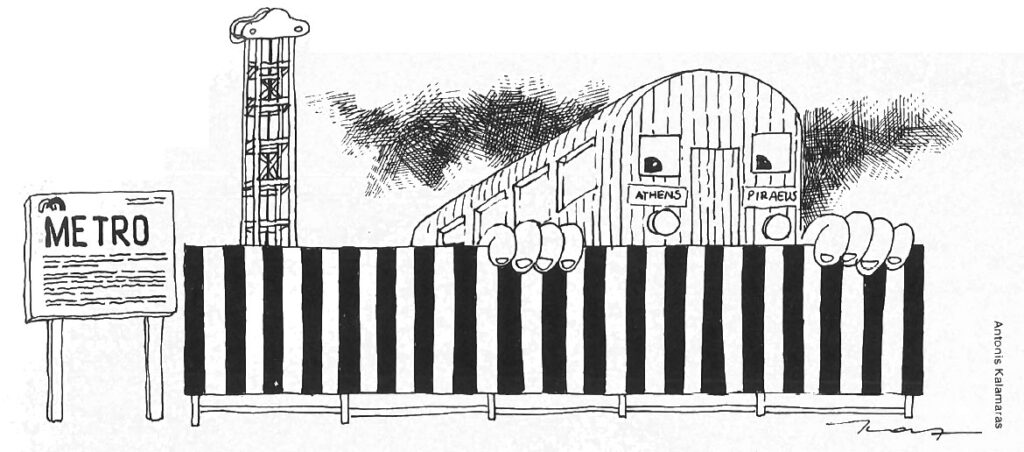
I happen to know that the real reason for opening these tunnels is an effort to trace the whereabouts of subway train No. 560 which left Omonia for Piraeus on Tuesday, July 7, at 9:40 a.m. and has not been seen or heard of since.
When the disappearance of the train was reported to executives of the subway company and after an extensive search of the track all the way to Piraeus and to Kifissia had proved fruitless, several theories were advanced to explain the mystery. One was that the train had been dematerialized by visitors from outer space and transported to a planet of Alpha Centauri where it would be reconstituted and examined by higher intelligences than ours. Another was that the train had somehow entered a time warp and was either careering between the Long Walls joining Athens to Piraeus in the days of Pericles or was jammed in the lobby of a 55-story apartment house in the year. The most likely theory, however, and the one that the subway company executives decided to investigate, was that the train had somehow jumped the rails somewhere between Omonia and Monastiraki and entered a subterranean waterway, opened up by the recent earthquakes. Such a waterway would either lead to the Ilissos or the Kifissos rivers, hence the decision to open tunnels at the points indicated above.

The government decided to hush up the disappearance of the train for two reasons. One was that it was already being severely criticized by public opinion for failing so far to discover and arrest the department store arsonists who had wrought havoc with impunity for several months. The other was the closeness of the forthcoming elections and that a vanishing train would be seized upon by the opposition as another example of sheer incompetence.
Indeed, what happened was that the handful of subway company people who were in on the secret
were enjoined to keep their mouths shut on pain of dire consequences if they did not, and with promises of rich rewards after the affair had blown over, if they did.
Nobody knew exactly how many people were on the train when it disappeared. But it was reckoned that many of them would have been tourists – the kind who travel with bare feet and their entire belongings on their back – on their way to Piraeus to take a ship to the islands. It was further reckoned that if they carried supplies with them, and if there had been a koulouri vendor on board, there would be enough food on the train to keep the passengers alive for a few days until it was found.
Subway engineers did find the hole between Omonia and Monastiraki into which the train had presumably disappeared, but its passage had apparently set up small tremors which had caused a tremendous rockfall behind it. The engineers estimated it would take as long to clear this blockage as it would to sink tunnels at other points and intercept the train as it was carried along the underground waterway.
Meanwhile, the anxious relatives of the vanished train passengers began reporting their disappearance to the police which simply added them to its bulging files on missing persons and promised to keep a lookout for them. Some of the relatives also gave photographs of their vanished kin to the television stations which were displayed by solemn TV announcers with descriptions of the clothes they were wearing at the time of their disappearance and the telephone numbers to call if they were seen. But since the TV stations never follow up these announcements with reports . on whether such missing persons have been found or not, the public at large remained unconcerned and the secret well kept.
A slight flap was caused, however, in government circles when the Foreign Ministry received a call from the ambassador of Merengue, a small republic on the west coast of Africa.
Apparently on the day of the train’s disappearance, his charge d’affaires and his naval attache had left for Piraeus to attend a morning reception and luncheon on a visiting French warship. Since it is impossible to find any parking space in Piraeus at that time of the day, they had told the ambassador they would be taking the subway from Omonia. They had not been seen since. As can be imagined, this caused considerable consternation at the Foreign Ministry and a cabinet meeting was called immediately. It was one thing to hush up the disappearance of a bunch of hippies and an insignificant collection of train passengers and quite another to explain the whereabouts of two foreign diplomats!
It could cause an international incident with far-reaching repercussions – and one shouldn’t forget those damned elections!
The cabinet meeting was just about to start when the Foreign Minister received another call from the Merenguan ambassador to say his charge d’affaires and his naval attache had turned up after all. Apparently they had taken an earlier train and, with time to kill in Piraeus, had stopped for an ouzo in one of the waterfront bars. There, they had succumbed to the fervid charms of two particularly attractive bar girls and had em barked on a torrid 48-hour binge. The ambassador apologized profusely and said he would be packing off his over-libidinous aides on the next plane to Merengue.
After the two tunnels had been sunk at Hadrian’s Arch and at Sepolia and the underground watercourse explored as far as the workmen could advance in safety, and no trace of the missing train had been found, it was decided it must have been swept out to sea.
Our story ends in the wireless cabin of a Coastguard patrol boat on duty in the Saronic Gulf. It received an urgent signal from the Ministry of Mercantile Marine which was marked TOP SECRET and read: “WHILE PATROLLING COASTAL AREA FROM PHALERON TO TZITZIFIES KEEP CLOSE LOOKOUT FOR MISSING SUBWAY TRAIN NO. 560 AND REPORT IMMEDIATELY ON SIGHTING.”
The skipper scratched his head and decided that his worst” fears about the lunacy of his superiors had at last been confirmed. But orders are orders. He picked up his binoculars and swept the empty sea before him, looking for anything that might remotely. resemble a subway train.







